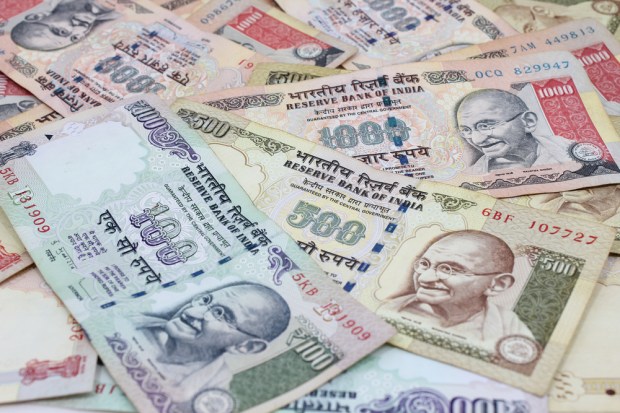India’s Grand (De) Monetization Experiment

Eight months in, assessing the impact of what happens when you remove 86 percent of a country’s notes in circulation. India’s push toward digital payments has had effects both positive and negative, and here’s a scorecard of sorts.
Picture cash. Wads of it. In mountains of crumpled notes and pristine notes. Rupee notes, in 500 and 1,000 denominations. Overflowing from wallets, pockets, purses … maybe mattresses.
Poof.
Gone. Gone like the wind. Kind of. Nigh eight months on, how has the grand demonetization experiment worked? Harken back to November, when Prime Minister Narendra Modi stated that those notes — a staggering majority of all tangible paper currency in circulation, at 86 percent — would be, literally, taken out of legal tender. Immediately.
The goals, numbering several, have been noble ones, simply put: To bring more people into the economy, to speed technology adoption and to cut down on tax evasion and black market activities.
But in a cash-rich society governed by tangible money crossing palms for almost every single transaction taking place, the stumbling blocks have been several, too. People spent time sleeping next to ATMs, waiting for the new 2,000 rupee notes that were coming in to replace the aforementioned smaller denominations. ATMs ran out of money. Currency couldn’t get to remote areas. People bartered.
So the growing pains were palpable, and real, and steady, at least in terms of adjusting to the physical change in the marketplace of doing business with cash. Those growing pains may have abated a bit, but not before crimping GDP growth, which upon announcement in May had slowed to 6.1 percent in the first quarter of the year, and which was a marked decline from the 7 percent rate seen in the previous quarter. The country’s annual growth rate for the 2016-2017 fiscal year slipped to 7.1 percent, off from 8 percent in the previous year. And also in May, the government had announced that several million new taxpayers had been found, pushing the roster a bit (and, of course, giving new revenue to the government).
One beneficiary of the shift has been Aadhaar, a technology initiative that has also helped the companies taking up the mantle of cashless payments. Aadhaar, to jog your memory, or perhaps jumpstart it, is a 12-digit ID that houses a wealth of data, both demographic and biometric. With almost all Indians above the age of 18 enrolling in the program, the success here is obviously widespread.
Identity is key, fostering both financial inclusion — to the tune of 270 million new bank accounts as of March 2017 — and security for the transactions themselves. Mobile reigns here. Smartphones reign within mobile, and the government introduced a United Payments Interface app that ties together interbank fund transfers and Aadhaar.
In addition, BharatQR also pushes payments crossing banks further in the mobile age, as it reads labels and uses mobile devices, aiding merchants. BharatQR also signals a collaboration between Visa, Mastercard, RuPay and American Express, banding together to streamline merchant transition to electronic payments by necessitating the use of POS, with more than a dozen banks poised for deployment as of late June.
One ancillary impact has been that enterprises such as Paytm have been boosting the services they offer to individuals. That company in particular has had to broaden its portfolio in order to fend off the threat from a standardized code that is interoperable with all banks, even while Paytm has its own QR system. The upshot has been that Paytm announced plans earlier this year to invest as much as $90 million USD in efforts to get merchants to use its own QR code-driven payment solutions.
Paytm has had its own competitive moat set in place, at least a bit, with its payments bank. It has also been getting merchants on board, eyeing its 220 million clients using its eWallets. The feet on the street have been enough to lure investors such as Alibaba.
Amazon, of course, has been ramping up its presence in the country too. While Softbank and Alibaba have put as much as $2 billion into Paytm, Jeff Bezos has signaled intent to invest with renewed vigor into the country, where the most visible ramp-ups have been via Amazon Prime. The recent acquisition of Whole Foods also gives some literal food for thought that Amazon will look to beef up delivery — in this case online grocery — in the country. This may all come on top of the $3 billion Bezos pledged to invest in India via an announcement that came last summer. The rise of cashless payments, in addition to the comfort level of using mobile devices and technology to aid shopping, make India a natural Amazon target.
Beyond the individual payments realm, smaller firms bounced back from initial setbacks. Initially SMEs had found it tough to complete simple operational tasks, such as make payroll, but more recently a survey from American Express found that the country’s smaller corporate entities are doing rather nicely in the wake of demonetization, with firms on the order of 73 percent of those surveyed stating that they are optimistic about India’s financial initiatives. Demonetization and tax reform (the latter took effect in June) have led to top line growth forecasts of 4 percent over the next year, as noted by three quarters of those queried by the card giant, and half stating that sales should grow by 8 percent.
Eight months in, it is still too early to judge what the longest-lasting impacts may be of demonetization, but some of the dynamics of who pays, when they pay and how they pay — and pay everything from taxes to supply chains — have clearly changed a bit, dovetailing with Modi’s original aims.
